

The
Devil in the White City: Murder, Magic, and Mayhem at the Fair That Changed
America by Erik Larson (Random House, 2003).
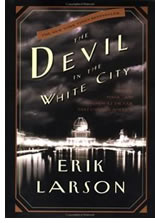 reviewed
by Stephanie Stubbs, Assoc. AIA
reviewed
by Stephanie Stubbs, Assoc. AIA
Can you feel it in the air? Chicago holds architectural mojo as no other city can do. It is possessed by the fresh, pioneering spirit of Sullivan, Burnham, Wright, the first skyscraper, a climb of steel and elevator to the sky, and the World Columbian Exposition of 1893 that rocketed the bold ascendancy of architecture as a profession and architects as keepers of can-do civic pride.
How neat: Erik Larson, who has captured that feeling in his national bestseller, The Devil in the White City: Murder, Magic, and Mayhem at the Fair That Changed America, will serve as opening keynoter at the AIA national convention, June 10 in Chicago.
A bold portrait
The White City was, of course, the 1893 World’s Fair, meant to celebrate
the 400th anniversary of Columbus’ arrival in the New World. Chicago
fought New York and Washington, D.C., long and hard for the honor of hosting
the exhibition, and Larson paints a bold portrait of a brash young city
eager to show the world what it’s made of.
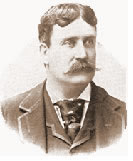 Daniel
Burnham, protagonist of The Devil in
the White City, and his partner John Root (who, tragically, died
before the fair was completed) led the venerable and veritable Who’s
Who of architects contributing to the Herculean effort. They included
(drum roll, please . . . ) Louis Sullivan, George Post, Charles McKim,
Richard Hunt, Robert Peabody, and Henry Van Brunt—the crème
de la crème of the design world and The American Institute of Architects.
The 21-year-old Sophia Hayden designed the Women’s Building. (She
got a $1,000 prize, Larson writes. The men each got $10,000.) Joining
them as landscape architect was none other than Frederick Law Olmsted.
Daniel
Burnham, protagonist of The Devil in
the White City, and his partner John Root (who, tragically, died
before the fair was completed) led the venerable and veritable Who’s
Who of architects contributing to the Herculean effort. They included
(drum roll, please . . . ) Louis Sullivan, George Post, Charles McKim,
Richard Hunt, Robert Peabody, and Henry Van Brunt—the crème
de la crème of the design world and The American Institute of Architects.
The 21-year-old Sophia Hayden designed the Women’s Building. (She
got a $1,000 prize, Larson writes. The men each got $10,000.) Joining
them as landscape architect was none other than Frederick Law Olmsted.
Heroes and heroics
It is thrilling to read Larson’s larger-than-life descriptions of
the architects and their work. He paints them as heroes, but then, aren’t
they? They designed and oversaw production of some 630 acres of parks
and 200 buildings (some absolutely humongous) on unstable soil in some
of the worst weather in a century. They battled fire and torrential rains,
cranky city officials and impossible deadlines. They improvised and sometimes
compromised, but they got the job done. And for a magnificent six months,
27.5 million visitors (the equivalent of one out of three people in the
country at the time) marveled at the White City and afforded Chicago a
new respect.
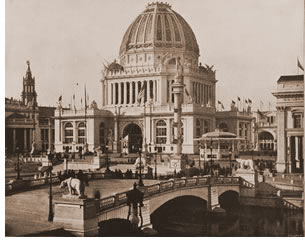 One
feels for Burnham in the trenches: “Burnham fought to boost the
rate of construction, especially of the Manufactures and Liberal Arts
Building, which had to be completed by Dedication Day,” Larson writes.
“In March, with just half a year remaining until the dedication,
he invoked the ‘czar’ clause of his construction contracts.
He ordered the builder of the Electricity Building to double his workforce
and to put the men to work at night under electric lights. He threatened
the Manufactures contractor with the same fate if he did not increase
the pace of his work.”
One
feels for Burnham in the trenches: “Burnham fought to boost the
rate of construction, especially of the Manufactures and Liberal Arts
Building, which had to be completed by Dedication Day,” Larson writes.
“In March, with just half a year remaining until the dedication,
he invoked the ‘czar’ clause of his construction contracts.
He ordered the builder of the Electricity Building to double his workforce
and to put the men to work at night under electric lights. He threatened
the Manufactures contractor with the same fate if he did not increase
the pace of his work.”
Providing stark contrast to Burnham’s good is another tale. The dark side of the book is a car wreck of horror at which you can’t help but stare. It’s the story of H.H. Holmes, né Herman Webster Mudgett, a coldly calculating mass murderer and classic psychopath who uses the fair’s lure to snare victims, who included three wives and actually may have numbered in the dozens. He specifically retrofitted buildings to serve as an intricate part of his destructive plans. (And you’ll have to read the book to find out how!).
A novelist’s soul
Larson’s compelling style zips both tales smoothly down mostly parallel
but sometimes crisscrossing tracks with deft speed that keeps curiosity
high. He tells such a good story that you forget you’re ingesting
history along with the narrative: “Larson is a historian . . . with
a novelist’s soul,” writes the Chicago
Sun-Times. Abetting him are both his meticulous research and the
turn-of-the-century’s lost art of letter writing that he skillfully
weaves into his tale.
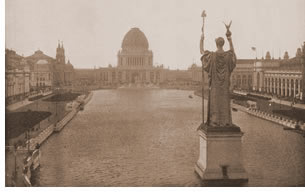 Describing
Olmsted’s landscaping parti, Larson writes, “Above all, he
wanted the exposition landscape to produce an aura of ‘mysterious
poetic effect.’ Flowers were not to be used as an ordinary gardener
would use them. Rather, each flower, shrub, and tree was to be deployed
with an eye toward how each would act upon the imagination. This was to
accomplish, Olmsted wrote, ‛the mingling intricately together of
many forms of foliage, the alternation and complicated crossing of salient
leaves and stalks of varying green tints in high lights with other leaves
and stalks, and therefore less defined and more shaded, yet partly illumined
by light reflected from the water.’”
Describing
Olmsted’s landscaping parti, Larson writes, “Above all, he
wanted the exposition landscape to produce an aura of ‘mysterious
poetic effect.’ Flowers were not to be used as an ordinary gardener
would use them. Rather, each flower, shrub, and tree was to be deployed
with an eye toward how each would act upon the imagination. This was to
accomplish, Olmsted wrote, ‛the mingling intricately together of
many forms of foliage, the alternation and complicated crossing of salient
leaves and stalks of varying green tints in high lights with other leaves
and stalks, and therefore less defined and more shaded, yet partly illumined
by light reflected from the water.’”
Readers be warned that the skill used to concoct visions of vegetative and constructed delight in the White City also paints the details of Chicago’s stockyards as well as Holmes’s dastardly deeds and their discovery. “The eeriest phase of the investigation began when the police, holding their flickering lanterns high, entered the hotel basement, a cavern of brick and timber measuring 50 by 165 feet. The discoveries came quickly: a vat of acid with eight . . . ”
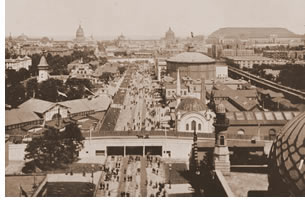 A
compelling legacy
A
compelling legacy
Larson’s narrative skill is buoyed by the fact that the 1893 World’s
Fair—as a slice of history—is just so darned interesting.
The fair brought us so many fascinating innovations, from AC incandescent
light bulbs to Cracker Jack to Buffalo Bill’s Wild West show. The
tale of design and construction of the world’s first Ferris Wheel,
Chicago’s nose-thumbing answer to the Paris World Expo’s Eiffel
Tower, presents its own absorbing, 250-foot-tall side show. But most importantly,
the fair spawned a style of architecture and the City Beautiful movement,
a new scope for city planning whose influences still are felt today.
The Devil offers a great read about the people and the buildings that shaped Chicago a century and several architectural mindsets ago. Its White side presents a perfect precursor to the AIA convention, evoking an almost palpable aura of Burnham, his friends, and their vast accomplishments. If nothing else, the book could transport us all a bit closer to the inexorable spirit that perennially brings us to “unite in fellowship” after all.
Copyright 2004 The American Institute of Architects.
All rights reserved. Home Page ![]()
![]()
 |
||
Purchase
The Devil in the White City online from the AIA Store (ISBN: 0375725601)
$14.95 list/$13.95 AIA members. Author Erik Larson will give the
opening keynote speech at the AIA National Convention in Chicago,
June 10. Register for the AIA Convention online (save $75 by registering
before May 14). Photos courtesy of the Paul V. Galvin Digital Library Collection, Illinois Institute of Technology. GREAT Web site: Would
you like to go to the Columbian Exposition?
|
||